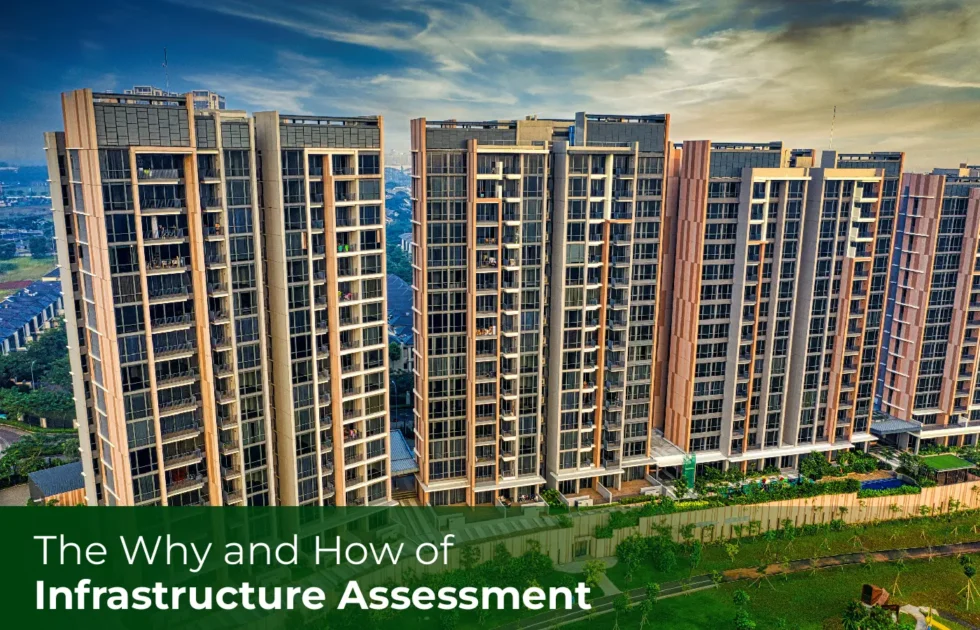Introduction:
Just imagine this: in the heart of a bustling metropolis like Mumbai, two buildings stand side by side, mirroring each other in design but not destiny. One is Surya Apartments, which gleams under the sun, its façade pristine, and its structure sound, a testament to meticulous maintenance. Chaya Complex is right next door, however, bearing the weight of neglect, with its peeling paint and the occasional crack scarring its walls. Now imagine the plight of residents of Chaya, who may have invested similar amounts in acquiring the apartments. This is a poignant reminder of the critical importance of Infrastructure Assessment.
The Why and How of Infrastructure Assessment
Infrastructure Assessment is not merely a responsibility but a necessity. Buildings, like living organisms, age and deteriorate over time. The harsh Indian climate, with its blistering summers, torrential monsoons, and, in some areas, chilly winters, accelerates this wear and tear. Minor issues can quickly escalate into major problems without regular maintenance, compromising the building’s safety, aesthetics, and value.
Read more about Infrastructure Assessment.
Safety First
The primary reason for Infrastructure Assessment is safety. Regular maintenance ensures that structural issues are identified and addressed promptly, preventing accidents and ensuring the well-being of the occupants. In 2017, Mumbai witnessed a tragic reminder of this need when a dilapidated building collapsed in Bhendi Bazaar, claiming 24 lives. Such catastrophes underline the dire consequences of neglect.
Aesthetic and Functional Value
A well-maintained building is not only safer but also more appealing and functional. It enhances the quality of life for its inhabitants and contributes positively to the neighbourhood’s aesthetic. In a country where urban spaces are increasingly crammed, maintaining each building can significantly impact the overall look and feel of the cityscape.
Economic Implications
From an economic perspective, regular assessment protects the building’s value. Real estate, particularly in India, represents a significant investment. Neglect can lead to depreciation, whereas diligent maintenance can enhance a property’s market value.
Moreover, addressing issues early can save money in the long run, preventing costly repairs or, in the worst case, being labelled unfit to live in and eventually collapsing the building. A case in point is the example of Bhindi Bazar, where a notice to vacate the building was issued to tenants. Fifty per cent of the occupants had evacuated the building, while the rest remained. The structure was old, and there were frequent complaints of leakages and, eventually, the collapse of the building.
Environmental Sustainability
Infrastructure Assessment also plays a crucial role in environmental sustainability. Efficiently maintained buildings consume less energy thanks to proper insulation, well-maintained HVAC systems, and timely repairs. This reduces the carbon footprint and decreases overall operational costs, a win-win for both the planet and the pocket.
Strategies for Effective Infrastructure Assessment
1. Regular Inspections: Scheduled checks are the cornerstone of preventive maintenance. These inspections can uncover potential problems before they escalate, from structural vulnerabilities to electrical or plumbing issues.
2. Timely Repairs: Procrastination in addressing identified issues can lead to more significant problems. Immediate action ensures that the building remains in top condition.
3. Quality Materials: High-quality materials for repairs or upgrades are crucial. They last longer and often require less maintenance, proving more cost-effective in the long run.
4. Professional Expertise: Employing experts for maintenance tasks ensures the work is done correctly and efficiently. Specialists bring in the necessary knowledge and tools to tackle specific problems.
5. Community Involvement: In residential buildings, involving the community can foster a sense of ownership and responsibility towards the assessment. Collective efforts can also pool resources for more significant maintenance projects.
6. Sustainability Practices: Incorporating green practices, such as rainwater harvesting, solar panels, and energy-efficient lighting, can enhance the building’s sustainability quotient.
The Road Ahead
As we reflect on the contrasting fates of Surya Apartments and Chaya Complex, the importance of regular Infrastructure Assessment cannot be overstated. It is a continuous journey requiring attention, investment, and commitment. In the Indian context, with its unique challenges and opportunities, this becomes even more critical.
The urban landscape of India is dotted with heritage structures, modern skyscrapers, and everything in between. Each building tells a story, contributes to the city’s character, and supports the lives within its walls. Ensuring their assessment is not just about preserving bricks and mortar but safeguarding our heritage, ensuring safety, enhancing living conditions, and securing economic value.
Conclusion:
As we move forward, let the tale of the two buildings remind us of the vital role that Infrastructure Assessment plays in our lives. Let it inspire us to take action, invest in maintenance, and work collectively towards a safer, more beautiful, and sustainable urban future.
Empower your future and safeguard your investment by prioritizing Infrastructure Assessment today. Join us in championing a safer, more sustainable, aesthetically pleasing urban landscape. Secure your peace of mind today.
Get in touch with us.

